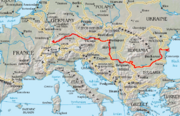Vukovar
| Vukovar | |
|---|---|
| — Town — | |
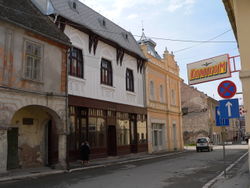 |
|
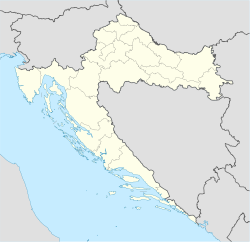 Vukovar
|
|
| Coordinates: | |
| Country | Croatia |
| County | Vukovar-Syrmia County |
| Government | |
| - Mayor | Željko Sabo (SDP) |
| Elevation | 108 m (354 ft) |
| Population (2001) | |
| - Total | 31,670 |
| Time zone | CET (UTC+1) |
| - Summer (DST) | CEST (UTC+2) |
| Postal code | 32 000 |
| Area code(s) | 032 |
| Website | vukovar.hr |
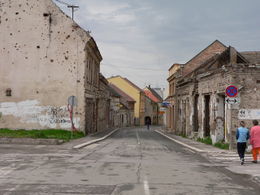

Vukovar is a city and municipality in eastern Croatia, and the biggest river port in Croatia located at the confluence of the Vuka river and the Danube. Vukovar is the center of the Vukovar-Srijem county. The city's registered population was 30,126 in the 2001 census, with 31,670 in the municipality.
Contents |
Name
The name Vukovar (Vukovár, Valkóvár, Вуковар) means "the town on the river Vuka" ('Vuko' from the river Vuka, and 'vár' from the Hungarian word for 'castle'). The name of the river Vuka itself originates from the Slavic word 'vuk', meaning 'wolf'.
Geography
It is located 20 km (12 mi) northeast of Vinkovci, 36 km (22 mi) southeast of Osijek with the elevation of 108 m (354 ft). Vukovar is located on the main road D2 Osijek—Vukovar—Ilok and on the Vinkovci—Vukovar railway (and road D55).
The city is spread out along the Danube river, and Vukovar proper is in the southeast while Borovo Naselje forms a distinct unit in the northwest.
Municipality
The municipality contains the villages of Lipovača, Sotin, and Grabovo.
In SFR Yugoslavia, the municipalities were generally larger, and the Vukovar municipality spanned the region from Vera and Borovo in the north, Ilok in the east and Tovarnik in the south, but it was since divided into several municipalities.
History
Early history
Slavic tribes settled in this area in the 6th century. In the 9th century, the region was part of the Slavic Balaton Principality ruled by prince Pribina, part of the Pannonian Croatia ruled by prince Ljudevit, and part of the Bulgarian Empire, while in the 11th-12th century, the region was part of the Kingdom of Croatia, while from the 13th to 20th century was part of the Hungarian Kingdom.
Vukovar was mentioned first in the 13th century as Volko, Walk, Wolkov (original Croatian/Slavic name of the town was Vukovo). Since the 14th century, the most common name used for the town was Vukovár. In the Hungarian Kingdom, Vukovár was a seat of the Szerém (Syrmia) county, which was located between rivers Drava and Sava. In the 16th-17th century, the town was occupied by the Ottoman Empire. In the end of the Ottoman rule, its population numbered about 3,000 inhabitants.
Since the end of the 17th century, Vukovar was part of the Habsburg Monarchy and was included into Kingdom of Slavonia, a Habsburg province that formally was part of both, the Kingdom of Croatia and the Kingdom of Hungary. During this time, Vukovar was a seat of the Syrmia county. Since 1868, when the Kingdom of Slavonia and the Kingdom of Croatia were joined into the single Kingdom called Croatia-Slavonia, Vukovar was part of this kingdom. In 1910, the population of Vukovar numbered 10,359 people, including 4,092 (39.50%) Croats, 3,503 (33.80%) Germans, 1,628 (15.70%) Serbs, 954 (9.20%) Hungarians, and 183 (1.80%) others.
Since 1918, Vukovar was part of the newly formed Kingdom of Serbs, Croats, and Slovenes (later known as Yugoslavia). Between 1918 and 1922, Vukovar was administrative seat of Syrmia (Szerém) county, and between 1922 and 1929 administrative seat of Syrmia oblast. Since 1929, it was part of the Sava Banovina, and since 1939 part of the Banovina of Croatia. Between 1941 and 1944, Vukovar was part of the Independent State of Croatia. During World War II the city was bombed by the Allies. In 2008 an unexploded bomb was found in the city from this period.[1] From 1945, it was part of the People's Republic of Croatia within new socialist Yugoslavia.
Vukovar during the Croatian War of Independence
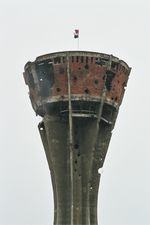
Vukovar was completely devastated during the Croatian War of Independence. The town had for months warded off the JNA-supported Serb military attacks on the city. 2,000 self-organised defenders (the army of Croatia was still in an embryonic stage at that time) defended the city for approximately 87 days against approx. 36 000 JNA (Serbian) troops aided with 110 vehicles and tanks, and dozens of planes when it was eventually overrun, with the city destroyed almost beyond recognition. It is estimated that 2,000 defenders of Vukovar and civilians were killed, 800 went missing and 22,000 civilians were killed or forced into exile.
Vukovar is notorious for the devastation it suffered, the worst in Europe since World War II, drawing comparisons with the World War II–era Stalingrad,[2][3] although Vukovar was on a much smaller scale. The watertower riddled with bullet holes, was retained by city planners to serve as a testimony to the events of the early 1990s.
On 18 November 2006 approximately 25,000 people from all over the country gathered in Vukovar for the 15th anniversary of the fall of the city, where they commemorated those who were killed. A museum dedicated to the siege was opened in the basement of the hospital that was attacked, which has now been rebuilt.[4]
On 27 September 2007, the International Criminal Tribunal for the former Yugoslavia convicted two former Yugoslav Army officers and acquitted a third of involvement in the hospital massacre.[5]
Demographics
In the years from 1948 until 1991 Vukovar's population increased quickly due to industrial development. Primarily it was immigration that fed the growth in the Vukovar region and in the town particularly. The region's population distribution changed notably too when the town of Ilok (Hungarian: Újlak) became the second largest town in the region.
The Croats were in the majority in most villages and in the region's eastern part, whereas the Serbs dominated in northwest. Vukovar's population was ethnically mixed and had 28 ethnic groups before the war.
Since the boundaries of the municipality have changed a few times, there are significant differences in the population census between '61 and '71, and '91 and '01.
| Year of census | total | Croats | Serbs | Others |
|---|---|---|---|---|
| 1961 | 54,707 | 24,527 (44.83%) | 22,774 (41.63%) | 7,406 (13.54%) |
| 1971 | 76,602 | 34,629 (45.21%) | 28,470 (37.17%) | 13,593 (17.09%) |
| 1981 | 81,203 | 30,157 (37.14%) | 25,146 (30.97%) | 25,903 (31.89%) |
| 1991 | 84,024 | 36,910 (43.93%) | 31,910 (37.98%) | 15,204 (18.09%) |
| 2001 | 31,670 | 18,199 (57.46%) | 10,412 (32.88%) | 3,059 (9.66%) |
In 2001, the municipality of Vukovar had a population of 31,670 people, including:[6]
- Croats (57.46%)
- Serbs (32.88%)
- Rusyns (1.79%)
- Hungarians (1.22%)
Particularly since the war in Croatia, much of the native Croat population has moved to other areas of Croatia or emigrated to Western Europe (notably Germany) or Austria and many Serbs have either moved to Serbia or to Canada and Western Europe.
Fifteen years after the war, in 2006, the city's ethnic makeup shows equal percentages of Serb and Croat residents.[7] The city remains very divided, as a deeper sense of reconciliation has failed to take root. The ethnic communities remain separated by mistrust, divided institutions and disappointment. Separate schooling for Croat and Serb children remains in place. Incidents involving Croats and Serbs occur regularly, and public spaces have become identified not by the services they offer but by the ethnicity of those who gather there. Even coffee shops are identified as Serb or Croat.[8]
Economy
Vukovar is the largest Croatian town and river port on the Danube. Its economy is based on trade, farming, viticulture, livestock breeding, textile and food-processing industry, footwear industry and tourism.
Following the end of the war, much of the infrastructure in Vukovar remains unrestored and unemployment is estimated to stand at 40 per cent. [8]
Cultural heritage
Among a number of attractive buildings, severely damaged in the recent war, the most interesting are the Eltz Manor of the Eltz noble family from 18th century, Baroque buildings in the centre of the town, the Franciscan monastery, the parish church of St. James, the Orthodox church of St. Nicholas, the birth house of the Nobel prize winner Lavoslav Ružička, etc. Since 1998 and peaceful reintegration under Croatian control, many buildings have been rebuilt, but there are many ruins still in the town.
Outside the town, on the banks of the Danube toward Ilok (Újlak), lies a notable archaeological site, Vučedol. The ritual vessel called the Vučedol Dove (vučedolska golubica) is considered the symbol of Vukovar. Vučedol is also a well-known excursion destination, frequented by anglers and bathers, especially the beautiful sand beach on Orlov Otok (Eagle's Island).
Sports and recreational opportunities are provided at the attractive confluence of the Vuka river into the Danube, on the promenades along the Danube and maintained beaches. Bathing is possible in the summer months. Angling is very popular both on the Vuka and the Danube (catfish, European perch, carp, pike, sterlet).
Education
Vukovar has seven primary schools and five high schools (including one gymnasium and one music school). The city is also home to the Lavoslav Ružička polytechnic, which offers study opportunities in the fields of economics and trade, law and kinesitherapy. Additionally, the University of Split runs dislocated studies in information technology, economics and law in Vukovar. Similarly, the University of Osijek offers programmes in economics and law.
Famous people from Vukovar
- Leopold Ružička - Nobel prize winner in chemistry
- Zaharije Orfelin - Serbian poet
- Ante Miše - Croatian football player
- Dario Zahora - Croatian football player
- Tomislav Mikulić - Croatian football player
- Damir Bičanić - Croatian handball player
- Siniša Mihajlović - Serbian football player
- General Woo - Croatian rap music singer
- Blago Zadro - Croatian general
- Siniša Glavašević - Croatian reporter
- Mirna Jukić - Croatian and Austrian swimmer
- Pavao Pavličić - Croatian writer
- Franjo Benzinger - Croatian pharmacist
- Tomislav Merčep - Croatian politician
- Vladimir Štengl - Former Member of Croatian parliament and former mayor of Vukovar
- Vlado Štefančić - Radio and TV presenter, actor, singer and dancer, theatre director
- Petar Mlinarić - Member of Croatian parliament
- Jakob Eltz - German nobleman and former member of Croatian parliament
International relations
Twin towns - Sister cities
Vukovar is twinned with:
References
Bibliography
- Cresswell, Peterjon; Atkins, Ismay; Dunn, Lily (10 July 2006). Time Out Croatia (First ed.). London, Berkeley & Toronto: Time Out Group Ltd & Ebury Publishing, Random House Ltd. 20 Vauxhall Bridge Road, London SV1V 2SA. ISBN 9781904978701. http://books.google.com/books?id=VZweAAAACAAJ. Retrieved 10 March 2010.
Notes
- ↑ Bomba iz 2.svjetskog rata u Vukovaru
- ↑ http://www.index.hr/vijesti/clanak.aspx?id=367100 (Croatian)
- ↑ Helen Seeney. "Croatia: Vukovar is Still Haunted by the Shadow of its Past | Inside Europe | Deutsche Welle | 22.08.2006". Dw-world.de. http://www.dw-world.de/dw/article/0,,2129420,00.html. Retrieved 2009-05-06.
- ↑ [1]
- ↑ Two jailed over Croatia massacre, BBC News, 27 September 2007. Retrieved 28 September 2007.
- ↑ "SAS Output". Dzs.hr. http://www.dzs.hr/Hrv/censuses/Census2001/Popis/H01_02_02/H01_02_02_zup16.html. Retrieved 2009-06-23.
- ↑ Vukovar: Day of remembrance, B92, 18 November 2006. Retrieved 2 October 2007.
- ↑ 8.0 8.1 Vukovar still divided 15 years on, B92, 27 November 2006. Retrieved 2 October 2007.
- ↑ "Bač". Skgo.org. http://www.skgo.org/php/opstine/detalji.php?Id=28&IdSvojstva=MO. Retrieved 2010-03-02.
External links
- Official site
- Tourist office Vukovar
- Vukovar Wikitravel page
- The Trinity of Vukovar - A Major Motion Picture
- HRT film footage of the 1991 siege of Vukovar
- Vukovar Youth Peace Group "Danube"
- Tourist office of the Vukovar-Sirmia County
- Tens of thousands gather for 15th anniversary of Vukovar siege
- Vukovar Still Divided 15 Years On,Institute for War and Peace Reporting, 24 November 2006
- Vukovar, hrvatski grad heroj - istinita priča; Vukovar, heroic city in Croatia - the true story
- Zaboravljene hrvatske žrtve (2): Vukovar - iz pismohrane Glasa Koncila
|
||||||||||||||||
|
||||||||
|
||||||||||||||||||||
